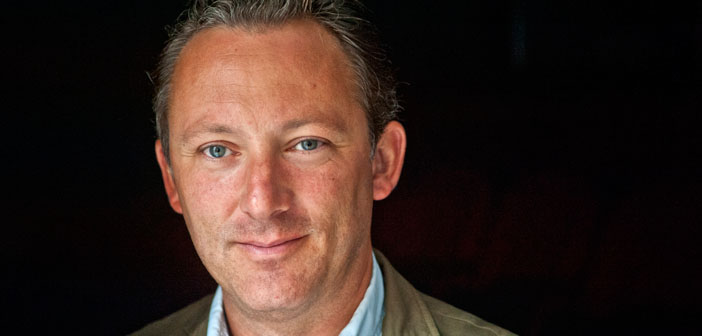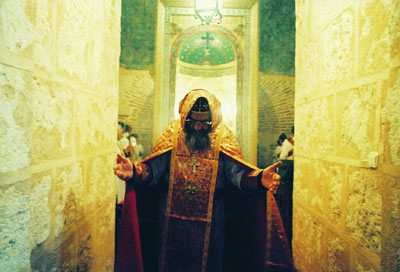"Sürgünün ne olduğunu Ortadoğu'da gördüm"


Sebastien de Courtois, ‘Babylon’un Irmaklarında, Ağlıyorduk’ kitabında 2014 yazında Şengal’den sürgün edilen Ezidilerin hikayesini anlatmış, Turabdin’deki tanıklıklarını kitaplaştırdığı ‘Süryaniler’ çalışması Yapı Kredi Yayınları’nda geçtiğimiz aylarda çıkmıştı. Courtois, avukatlık yaptığı 1998 yılında Midyat’taki Mor Gabriel Manastırı’nı gördükten sonra bir kırılma yaşamış. Doktora tezini Süryaniler üzerine yapan ve gazeteciliğe başlayan Courtois, Süryanilerin ardından çalışmalarını Ortadoğu azınlıkları üzerinde yoğunlaştırdı.
2014 Ağustos’unda Ezidilerin Şengal’den sürgününü izlemek üzerine bölgeye giden Courtois’la, söyleşi öncesinde yaptığımız sohbette Ezidilerin kilometrelerce çölde yürümelerinin görsellerinin, Ermeni Soykırımı sırasında tehcir rotalarında çekilmiş ve bugüne kalan fotoğraflarla benzer olup olmadığını konuşuyoruz. Courtois, ‘Orada yerliler bana ‘1915 yine başladı’ demişlerdi. Ama tarihçi gözüyle benzerlik kurmanın tehlikeli olduğunu düşünüyorum. Bu korkunç gerçekliğin tarihte olanla ilişkisi, farklı birşey olmasa da farklı bir gerçeklik” diyor.
 Courtois'in 'Süryaniler' kitabından.
Courtois'in 'Süryaniler' kitabından. 2014’te IŞİD’in Şengal saldırısı başladıktan sonra sınıra gittiniz. İlk izlenimleriniz nelerdi?
Bir gazeteci olarak oraya olabildiğince çabuk gitmek görevimdi. Musul’da ordunun çekildiği ve IŞİD’in girdiği 16 Haziran’da, yeni hedefin Musul’un 40 kilometre doğusundaki Hıristiyan yerleşimi olduğu açıktı. 6-7 Ağustos’ta da bu gerçekleşti. Diyarbakır, Silopi ve Cizre hattından Irak sınırını geçtik. Binlerce Ezidi vardı. Yanlarında hiçbirşey yoktu. Sakinlerdi, sadece biraz yemek ve su bekliyorlardı. Biraz daha güneye, Duhok’a gittik. Orada, hiçbir imkânı olmayan kamplarda binlerce insan olduğunu gördük. 2-3 günlük,bazıları için 4 günlük bir yolu aşıp Sincar’dan oraya geldiklerini söylediler. 45 derecede çölde yürümüşlerdi. Gelip doğrudan konuşuyorlardı. Travmadan sonra konuşmaya ihtiyaçları vardı. Hepsi aynı hikâyeleri, katliamları anlatıyordu. Kaçırılan kızlar, kadınlar.. Bir kadın IŞİD’in bir bebeği ellerinden aldığını ve öldürdüğünü söylemişti. Böyle bir durumda bir gazeteci olarak kendinizi işe yaramaz hissediyorsunuz. Hayatımda ilk defa sürgünün ne olduğunu Ortadoğu’da gördüm.
IŞİD’den önce Irak ve Suriye’deki Hıristiyan azınlıkların durumu nasıldı?
Irak ve Suriye arasındaki sorun 2003’teki ABD işgali sırasında başladı. Sorumlusu da Irak Geçici Koalisyon Yönetimi Başkanı L. Paul Bremer ve George Bush’tur. 2003’ten itibaren azınlık ve çoğunluk arasındaki denge zaten zor durumdaydı. Açık ki, en zayıf olan hayatta kalamaz. Hıristiyanlar, Ezidiler, Türkmenler, tüm bu azınlık gruplar çoğunluk tarafından düşman, yabancı olarak görülmeye başlandı. Halbuki yerli Hıristiyanlar bölgede 2 bin yıldır yaşıyor. Unutmamalıyız ki, bölgedeki Müslüman yerel halk önceden Hıristiyan’dı. Bugün, modern mantık ve cehalet onları yabancı olarak görse de Hıristiyanlar Ortadoğu’da toplumun kurucuları. Bunu sokakta, gündelik hayatta da görebilirsiniz.
“Fransa’da kamuoyunun çoğu mültecilere karşı ama bu zihin yapısını değiştirmek de bizim görevimiz. Bu da inkârla olmaz, yüzleşmekle olur.”
Özellikle Suriye’deki Hıristiyan azınlıkların büyük bir kısmı, çoğu Suriyeli gibi Ortadoğu’yu terk etmek zorunda kaldı. İltica eden Hıristiyanlara karşı Avrupa’da farklı bir yaklaşım var mı?
Umurlarında değil. Sadece umurlarında gibi davranıyorlar. Benim hükümetim, Fransa açısından bakınca bu durum ironik elbette. Son dört senede yaptıklarımızla Suriye’de savaşın devam etmesinin nedenlerinden biri olduk. Şimdi de mültecileri alarak bedelini ödüyoruz. Elbette almalıyız, çünkü bu durumdan bir açıdan sorumluyuz.
Fransa’da geçtiğimiz günlerde bazı belediye başkanları Hıristiyan mültecilerin alınması hakkında açıklamalar yapmıştı. Buna ne diyorsunuz?
Benim için bu kabul edilemez. Silah ticareti yaparken dinleri sormuyorsak mültecileri kabul ederken de dinlerini sormamalıyız. Ama onları da suçlamak istemem. Her fikre saygı göstermek gerekir çünkü bu açıklamalar kamuoyundaki bir düşünceyi ifade eder. Çoğu insanın böyle düşündüğünü ama bunu söylemeye cesaret edemediğini düşünüyorum.
Kamuoyu tam olarak ne düşünüyor?
İnsanlar korkuyor. İnsanların yollarda yürüdüğünü, denize girdikleri sahilde insanların öldüğünü görüyorlar ve ‘ne oluyor?’ diyorlar. Kapının önünde olanı anlamazsan orada ne olduğunu da anlayamazsın. Şimdi belki onların da insan olduğunu düşünecekler. Ama herkesin de böyle düşünmediği, düşünmeyeceği gerçeğini de görmek lazm. Fransa’da kamuoyunun çoğu mültecilere karşı ama bu zihin yapısını değiştirmek de bizim görevimiz. Bu da inkârla olmaz, yüzleşmekle olur.
 Courtois'in 'Süryaniler' kitabından
Courtois'in 'Süryaniler' kitabındanBugün Süryaniler Irak’ta ne koşullarda yaşıyor?
Süryanilerin büyük kısmı Karakuş’ta yaşıyordu. 2003’ten önce Irak’ta bir milyon Hıristiyan vardı, şimdiyse bu sayının 200 binle 400 bin arasında olduğu tahmin ediliyor, tam sayıyı bilmiyoruz. Çoğunlukla Kürdistan özerk bölgesinde barış içinde yaşıyorlar. Ama memleketlerine bir an önce dönmek istiyorlar. Ama IŞİD’in kendi isteğiyle çıkmaya niyeti yok. Geleceği ise kimse bilmiyor.
‘Kültürel mirasta hiyerarşi kabul edilemez’
Söyleşiden önce Mor Gabriel Manastırı’nı görmenin sizin hayatınızda nasıl bir dönüm noktası olduğundan bahsetmiştiniz. Anadolu’da yok olan ya da harap haldeki kiliseleri gördüğünüzde ne hissediyorsunuz?
Harap haldeki kiliseleri gördüğümde gerçek manada ağlıyorum. Gürcülere, Rumlara, Ermenilere, Süryanilere, Ezidilere ait ibadethaneler, Artuklu ya da Selçuklu mirasından daha önemsiz ya da daha az Anadolulu değil. Kültürel miras arasında bir hiyerarşi yaratmak kabul edilebilir değil. Çünkü bu yapılar ülkedeki her insana ait oldukları gibi insanlığa da aitler. Onları böyle görmek bana acı veriyor çünkü onları kurtarmak için esasında hiçbir şey yapılmadı. Bazı istisnalar var elbette; Ahtamar Kilisesi, Sümela Manastırı, Mardin’deki Deyrulzafaran Manastırı gibi. Ama bu yerler de bir tür tanıtım amacıyla restore edildi. Kültürel mirasa dair geniş çaplı bir araştırma yapmak bu kadar zor olmamalıydı. Bu açıdan baktığımda Türkiye’nin başına gelebilecek iyi bir lider ‘hepimiz bu ülkenin bir parçasıyız ve Türkiye farklılığından gurur duyuyor” diyen lider olacak diye düşünüyorum. Bu anıtların Batı ile Doğu arasındaki bir ayrımın değil, bugün geçmiş ve medeniyetler arasında bir bağın işareti olduğunu görmek gerekiyor. Hasankeyf’e bakın, Artuklu zamanından kalma, Anadolu’nun en eski türbesi (Zeynel Bey Türbesi) bulunuyor orada ama o da kimsenin umrunda değil. Bunun siyasetle ilgisi yok, geçmişi kabul edip etmemeyle ilgisi var.


